
Concept explainers
(a)
Interpretation: The relation between the compounds A and B is to be determined.
Concept introduction: Newman projections are drawn to visualize the different conformations of a compound around
The stereochemistry of the compound is determined by prioritizing the groups attached to its stereogenic center. The groups are prioritized on the basis of
Answer to Problem 5.61P
Compounds A and B are identical.
Explanation of Solution
The given Newman projection A is,

Figure 1
In Newman projection, the circle represents the back carbon and the dot represents the front carbon. The back carbon is substituted by one hydroxyl, one hydrogen atom and one hydroxymethyl group and the front carbon is substituted by one hydrogen atom, one hydroxyl group and one formyl group. The skeletal structure for the given projection is,
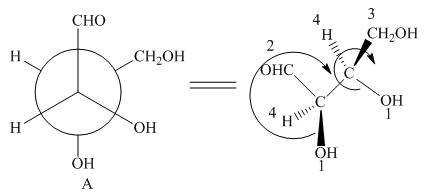
Figure 2
In the given compound,
The given Newman projection B is,
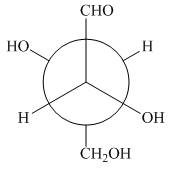
Figure 3
In Newman projection the circle represents the back carbon and the dot represents the front carbon. The back carbon is substituted by one hydroxyl, one hydrogen atom and one hydroxymethyl group and the front carbon is substituted by one hydrogen atom, one hydroxyl group and one formyl group. The skeletal structure for the given projection is,

Figure 4
In the given compound,
Both A and B have same configuration around the stereogenic centers. Hence, compounds A and B are identical.
Compounds A and B are identical.
(b)
Interpretation: The relation between the compounds A and C is to be determined.
Concept introduction: Newman projections are drawn to visualize the different conformations of a compound around
The stereochemistry of the compound is determined by prioritizing the groups attached to its stereogenic center. The groups are prioritized on the basis of atomic number of their atoms. The group that contain atom with higher atomic number is given higher priority. Complete the circle in decreasing order of priority from
Answer to Problem 5.61P
Compounds A and C are enantiomers.
Explanation of Solution
The given Newman projection A is,

Figure 1
In Newman projection the circle represents the back carbon and the dot represents the front carbon. The back carbon is substituted by one hydroxyl, one hydrogen atom and one hydroxymethyl group and the front carbon is substituted by one hydrogen atom, one hydroxyl group and one formyl group. The skeletal structure for the given projection is,

Figure 2
In the given compound,
The given Newman projection C is,
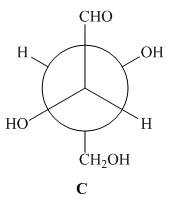
Figure 5
In Newman projection the circle represents the back carbon and the dot represents the front carbon. The back carbon is substituted by one hydroxyl, one hydrogen atom and one hydroxymethyl group and the front carbon is substituted by one hydrogen atom, one hydroxyl group and one formyl group. The skeletal structure for the given projection is,

Figure 6
In the given compound,
Both A and C have opposite configuration around the stereogenic centers. Hence, compounds A and C are enantiomers.
Compounds A and C are enantiomers.
(c)
Interpretation: The relation between the compounds A and D is to be determined.
Concept introduction: Newman projections are drawn to visualize the different conformations of a compound around
Enantiomer of a compound has opposite configuration at stereogenic centers. Diastereomers of a compound have at least one stereogenic centre with same configuration and at least one with opposite configuration.
Answer to Problem 5.61P
Compounds A and D are diastereomers.
Explanation of Solution
The given Newman projection A is,

Figure 1
In Newman projection, the circle represents the back carbon and the dot represents the front carbon. The back carbon is substituted by one hydroxyl, one hydrogen atom and one hydroxymethyl group and the front carbon is substituted by one hydrogen atom, one hydroxyl group and one formyl group. The skeletal structure for the given projection is,

Figure 2
In the given compound,
The given Newman projection D is,
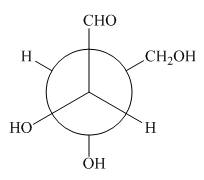
Figure 7
In Newman projection the circle represents the back carbon and the dot represents the front carbon. The back carbon is substituted by one hydroxyl, one hydrogen atom and one hydroxymethyl group and the front carbon is substituted by one hydrogen atom, one hydroxyl group and one formyl group. The skeletal structure for the given projection is,
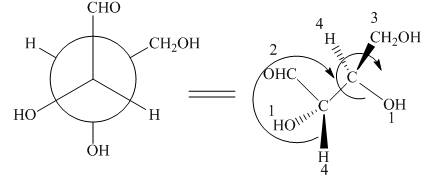
Figure 8
In the given compound,
Both A and D have one stereogenic centre with same configuration and one with opposite configuration. Hence, A and D are diastereomers.
Compounds A and D are diastereomers.
(d)
Interpretation: The relation between the compounds C and D is to be determined.
Concept introduction: Newman projections are drawn to visualize the different conformations of a compound around
Enantiomer of a compound has opposite configuration at stereogenic centers. Diastereomers of a compound have at least one stereogenic centre with same configuration and at least one with opposite configuration.
Answer to Problem 5.61P
Compounds C and D are diastereomers.
Explanation of Solution
The given Newman projection C is,

Figure 5
In Newman projection the circle represents the back carbon and the dot represents the front carbon. The back carbon is substituted by one hydroxyl, one hydrogen atom and one hydroxymethyl group and the front carbon is substituted by one hydrogen atom, one hydroxyl group and one formyl group. The skeletal structure for the given projection is,

Figure 6
In the given compound,
The given Newman projection D is,

Figure 7
In Newman projection the circle represents the back carbon and the dot represents the front carbon. The back carbon is substituted by one hydroxyl, one hydrogen atom and one hydroxymethyl group and the front carbon is substituted by one hydrogen atom, one hydroxyl group and one formyl group. The skeletal structure for the given projection is,

Figure 8
In the given compound,
Both C and D have one stereogenic centre with same configuration and one with opposite configuration. Hence, compounds C and D are diastereomers.
Compounds C and D are diastereomers.
Want to see more full solutions like this?
Chapter 5 Solutions
Organic Chemistry
- a hexose if it has 6 C's, and so forth. ? Explainarrow_forwardThe structure of 4 isomers of an aldotetrose carbohydrate are given. 1) select every structure that is a diastereomer of structure D A, B, or C? 2) select every structure that is a enantiomer of structure C D, B, or A? 3) select every structure that is a stereoisomer of structure D A, B, or Carrow_forwardClassify attached pair of compounds as constitutional isomers or stereoisomers ?arrow_forward
- Which has the greater polarizability? Explain.(a) Br- or I- (b) CH2 = CH2 or CH3—CH3 (c) H2O or H2Searrow_forwardAre α- D-glucose and β- D-glucose enantiomers? Explain your choice.arrow_forwardarre the ff chiral or achiral? draw the structures of the enantiomers for chiral compounds a. 1-chloro-2-methylbutane b. 2-bromopentanearrow_forward
- A(n) ________ is an achiral compound that contains chiral centers but is superimposable on its mirror image. A) constitutional isomers B) conformational isomers C) enantiomers D) diastereomers E) meso compoundsarrow_forward2) What is the difference between stereoisomers and enantiomers?arrow_forwardGentiobiose (D‑Glc(β1→6)D‑Glc) is a disaccharide found in some plant glycosides. Draw the Haworth structure of gentiobiose based on its abbreviated name. Show all multiatom groups using the groups tool. Show stereochemistry using wedge (upward) or dash (downward) bonds. The structures attached are not correct on Connect. Please consider a correct structure.arrow_forward
 Chemistry for Today: General, Organic, and Bioche...ChemistryISBN:9781305960060Author:Spencer L. Seager, Michael R. Slabaugh, Maren S. HansenPublisher:Cengage Learning
Chemistry for Today: General, Organic, and Bioche...ChemistryISBN:9781305960060Author:Spencer L. Seager, Michael R. Slabaugh, Maren S. HansenPublisher:Cengage Learning Introductory Chemistry: A FoundationChemistryISBN:9781337399425Author:Steven S. Zumdahl, Donald J. DeCostePublisher:Cengage Learning
Introductory Chemistry: A FoundationChemistryISBN:9781337399425Author:Steven S. Zumdahl, Donald J. DeCostePublisher:Cengage Learning Chemistry: Principles and ReactionsChemistryISBN:9781305079373Author:William L. Masterton, Cecile N. HurleyPublisher:Cengage Learning
Chemistry: Principles and ReactionsChemistryISBN:9781305079373Author:William L. Masterton, Cecile N. HurleyPublisher:Cengage Learning
 World of Chemistry, 3rd editionChemistryISBN:9781133109655Author:Steven S. Zumdahl, Susan L. Zumdahl, Donald J. DeCostePublisher:Brooks / Cole / Cengage Learning
World of Chemistry, 3rd editionChemistryISBN:9781133109655Author:Steven S. Zumdahl, Susan L. Zumdahl, Donald J. DeCostePublisher:Brooks / Cole / Cengage Learning Introduction to General, Organic and BiochemistryChemistryISBN:9781285869759Author:Frederick A. Bettelheim, William H. Brown, Mary K. Campbell, Shawn O. Farrell, Omar TorresPublisher:Cengage Learning
Introduction to General, Organic and BiochemistryChemistryISBN:9781285869759Author:Frederick A. Bettelheim, William H. Brown, Mary K. Campbell, Shawn O. Farrell, Omar TorresPublisher:Cengage Learning





